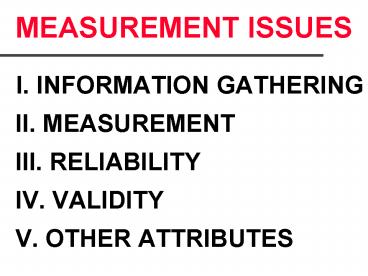MEASUREMENT ISSUES PowerPoint PPT Presentation
1 / 35
Title: MEASUREMENT ISSUES
1
MEASUREMENT ISSUES
- I. INFORMATION GATHERING
- II. MEASUREMENT
- III. RELIABILITY
- IV. VALIDITY
- V. OTHER ATTRIBUTES
2
Gathering Information
- What to look for
- Hypotheses Variables
- Whats known?
- Anything missing?
- Measures
- How Operationalized
- Reliability/Validity evidence
- Sources of data
3
Gathering Information
- What to look for
- Where to look
- Using what you find
4
MEASUREMENT
- Nature of Measurement
5
MEASUREMENT
- Levels of Measurement
- Nominal
- Ordinal
- Interval
- Ratio
6
Level of Analysis
- Is the variable of interest an individual, team,
or company (etc.) phenomenon? - Examples
- Individual - Pay satisfaction, Turnover
intentions, Product knowledge - Team - Norms, Cohesion, Decision quality,
- Company - Climate, Turnover rate, Market share
7
RELIABILITY
- Nature
- Observed Score
- True Score Error
8
Sources of Error
- Respondent
- Administrator
- Conditions
- Coder/Scorer
- Attribute
9
RELIABILITY
- Nature
- Sources of Error
- Systematic vs. Random Error
10
Random Error
(Trochim Fig. 3-7 on p. 61)
11
Systematic Error
(Trochim Fig. 3-8 on p. 62)
12
Test-Retest Reliability
- Stability over time
- Assumes stable construct
(Trochim Fig. 3-19 on p. 67)
13
Parallel-Forms Reliability
- Stability across forms
(Trochim Fig. 3-20 on p. 67)
14
Split-Half Reliability
- Consistency within a measure
(Trochim Fig. 3-23 on p. 69)
15
Split-Half Example
- Navigation Dimension of Socialization Scale
- 12. I have learned how to effectively deal with
the bureaucracy or red tape in the MLHR
program. - 15. I know how to act and behave in the MLHR
program. - 16. I have not learned what it really takes to
get ahead in the MLHR program. (R) - 22. I have learned the unwritten rules in the
MLHR program for how to stay in good standing. - 25. I know what is expected of me in the MLHR
program beyond my performance in classes. - Correlation of even items with odd items
16
Estimating Reliability
- Cronbachs Alpha Reliability
- Like the average of all possible split-half
correlations. - Calculated as
17
Alpha Examples
- SCALE ALPHA
- Goal Commitment
- Socialization
- People
- Navigation
- Language
- Engagement
- Work Motivation
- Job Satisfaction
- Turnover Intentions
18
Inter-Rater Reliability
- Consistency across observers
(Trochim Fig. 3-18 on p. 66)
19
What is Reliable Enough?
20
VALIDITY
- To what extent do your inferences or conclusions
reflect the truth? - Are you measuring the right thing?
- Its better to measure the right thing with some
error than to perfectly measure the wrong thing.
21
(No Transcript)
22
CONSTRUCT VALIDITY
- Can we generalize to the constructs?
(Trochim Fig. 3-1 on p. 53)
23
CONSTRUCT VALIDITY
24
CONSTRUCT VALIDITY
- Example - Goal Commitment Scale
- Across multiple studies, settings, samples,
the scale has consistently been shown to be - Reliable (alpha test-retest)
- Related to its expected causes
- Related to its expected effects
- Unrelated to unexpected effects
25
CRITERION-RELATEDVALIDITY
INDEPENDENT VARIABLE
DEPENDENT VARIABLE
Observed Relationship
Observation
What you test
26
CRITERION-RELATEDVALIDITY
27
CRITERION-RELATEDVALIDITY
28
CRITERION-RELATEDVALIDITY
29
CONTENT VALIDITY
30
CONTENT VALIDITY
31
VALIDITY
32
CASE - Phonemin Co.
- How was reliability estimated?
- Are the tests reliable enough?
- How were thy validated?
- Are the tests valid enough?
- Limitations to keep in mind?
33
Internal Validity
- How confident are we that the conclusions reached
in this study reflect the truth? Given our
research design and measures, how confident are
we in our results? - Did the independent variable variable cause the
dependent variable or are there potential
alternative explanations?
34
External Validity
- How confident are we that the conclusions reached
in this study would also be true in other
contexts? - Can we generalize our findings to other persons,
places, settings and times?
(Trochim Fig. 2-2 on p. 28)
35
OTHER ATTRIBUTES
- NORMS
- LEGALITY
- RESPONDENT REACTIONS

